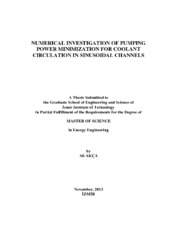Please use this identifier to cite or link to this item:
https://hdl.handle.net/11147/3665Full metadata record
| DC Field | Value | Language |
|---|---|---|
| dc.contributor.advisor | Özkol, Ünver | en |
| dc.contributor.author | Akça, Ali | - |
| dc.date.accessioned | 2014-07-22T13:52:04Z | - |
| dc.date.available | 2014-07-22T13:52:04Z | - |
| dc.date.issued | 2013 | en |
| dc.identifier.uri | http://hdl.handle.net/11147/3665 | - |
| dc.description | Thesis (Master)--Izmir Institute of Technology, Energy Engineering, Izmir, 2013 | en |
| dc.description | Includes bibliographical references (leaves: 70-71) | en |
| dc.description | Text in English; Abstract: Turkish an English | en |
| dc.description | xiii, 71 leaves | en |
| dc.description | Full text release delayed at author's request until 2016.12.03 | en |
| dc.description.abstract | The electronic devices consume more energy with the increasing their process capacity. Therefore, their temperature increase and unless they are cooled down sufficiently, electronic devices exceed the safety operating temperature and break down. Improvements in electronic technology are obtained as this heat transfer bottleneck is overcome. Moreover, this cooling system consumes electric power as well and this should be minimized. In this thesis, minimization study of the consumed energy to cool down an electronic device is carried out. In this study, the heat transfer in the rectangular cross-sectional sinusoidal wavy channels is investigated numerically and heat transfer augmentation is considered with reference to a straight channel geometry. Minimization of the surface temperature and the pump power are elaborated for the different wave amplitudes and wavelengths in the channel. The flow in the channel is conducted at the range of Re numbers from 7 to 368 and it assumed laminar and steady state condition. Dissipating heat flux from the electronic module is assumed to be constant. Thermal performance is calculated with observing of the temperature of the critic device on the electronic module and the pump power is evaluated by utilizing pressure drop calculations in the channel. To investigate how the sinusoidal wavy channel affects the cold plate compared to the straight channel, some dimensionless numbers are defined and the assessments are done in accordance with these numbers. Generally, it was observed that, sinusoidal wavy channel contributes the heat transfer enhancement. While wave amplitude affects heat transfer positively, pump power is affected adversely. Wavelength effect is not important comparing with wave amplitude for the augmentation of heat transfer performance. Nevertheless, it was observed that the increasing the wavelength causes to decrease pump power. | en |
| dc.language.iso | en | en_US |
| dc.publisher | Izmir Institute of Technology | en |
| dc.rights | info:eu-repo/semantics/openAccess | en_US |
| dc.subject.lcsh | Heat sinks (Electronics) | en |
| dc.subject.lcsh | Electronic apparatus and appliances--Cooling | en |
| dc.title | Numerical investigation of pumping power minimization for coolant circulation in sinusoidal channels | en_US |
| dc.type | Master Thesis | en_US |
| dc.institutionauthor | Akça, Ali | - |
| dc.department | Thesis (Master)--İzmir Institute of Technology, Energy Systems Engineering | en_US |
| dc.relation.publicationcategory | Tez | en_US |
| item.languageiso639-1 | en | - |
| item.fulltext | With Fulltext | - |
| item.openairecristype | http://purl.org/coar/resource_type/c_18cf | - |
| item.openairetype | Master Thesis | - |
| item.grantfulltext | open | - |
| item.cerifentitytype | Publications | - |
| Appears in Collections: | Master Degree / Yüksek Lisans Tezleri | |
Files in This Item:
| File | Description | Size | Format | |
|---|---|---|---|---|
| 10013372.pdf | MasterThesis | 2.5 MB | Adobe PDF |  View/Open |
CORE Recommender
Page view(s)
118
checked on Jul 22, 2024
Download(s)
54
checked on Jul 22, 2024
Google ScholarTM
Check
Items in GCRIS Repository are protected by copyright, with all rights reserved, unless otherwise indicated.